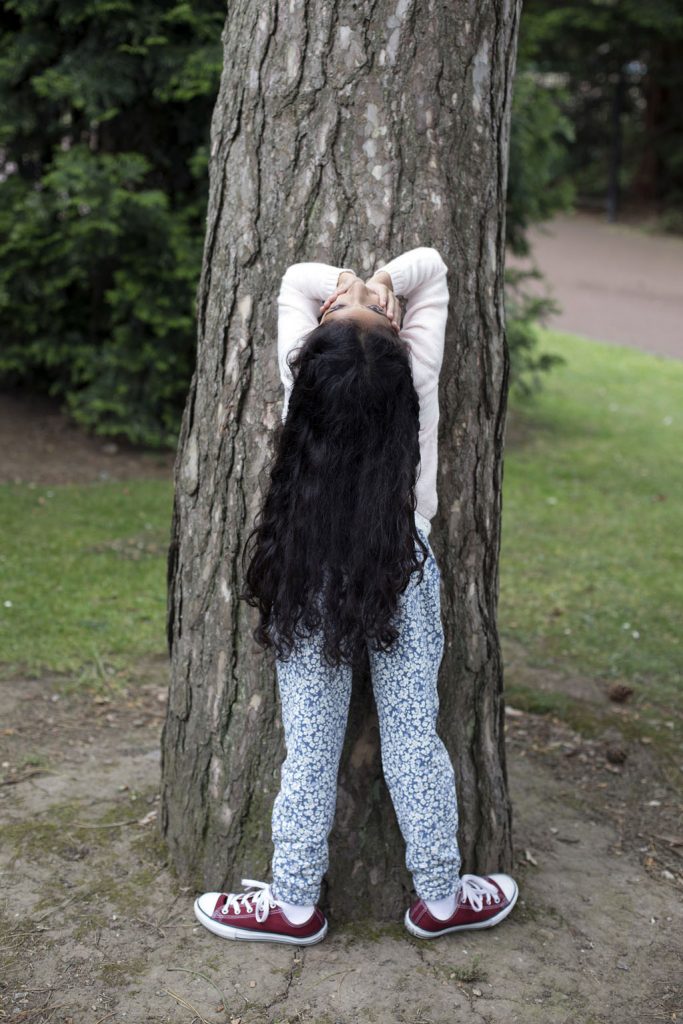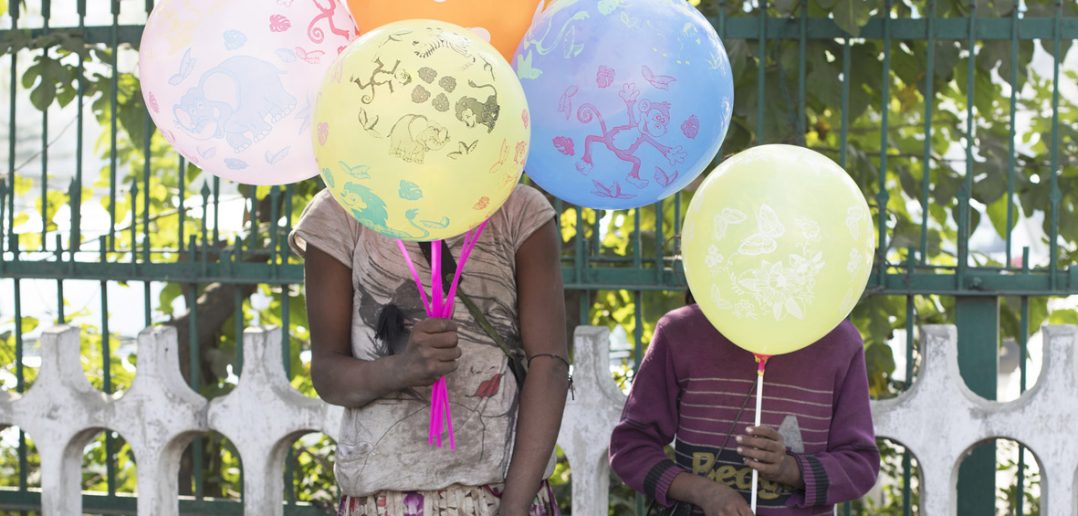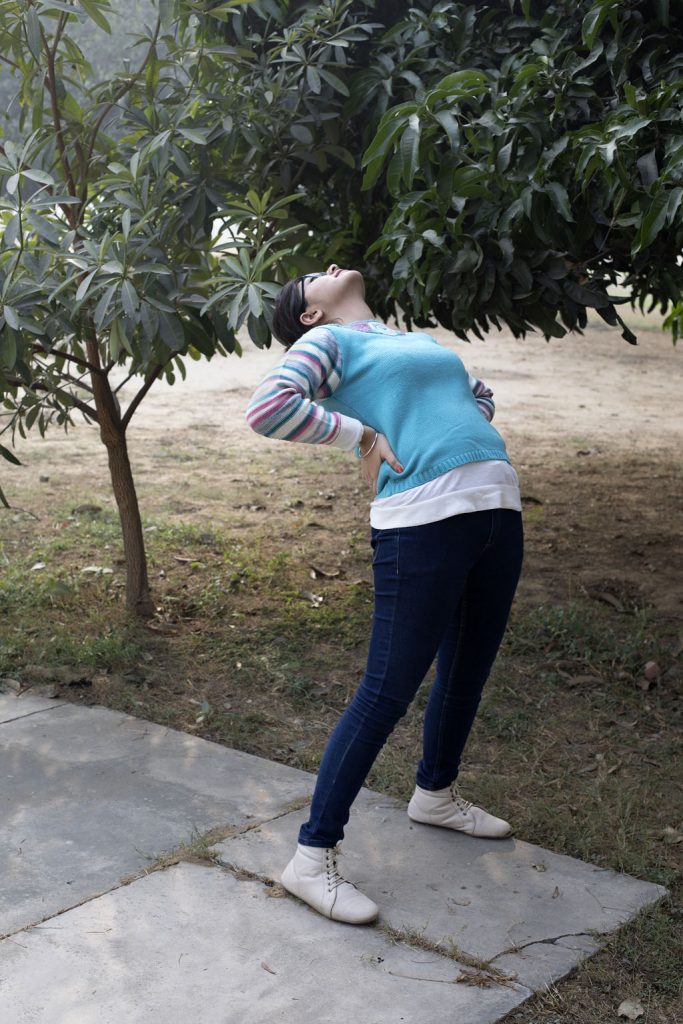Girl Gaze Jocelyn Allen
Jocelyn Allen’s You Will Live in This World as A Daughter is a series of playful portraits of girls and young women that explores what it is to be born a daughter of the Punjab. Behind her playful portrayals is a meaningful enquiry into their visibility within traditionally patriarchal communities.
Jocelyn often appears within her personal work, whilst exploring themes of representation, self-esteem, anxiety, hiding/revealing and identity. Girl Gaze sees her pushing boundaries within her own practice taking her far outside of her comfort zone to produce a set of images that showcase confident females.
How did you begin to think about tackling the Reimagine commission?
I did some research and quickly found that the ratio between women and men in the Punjab is lower than the national average, so I knew that I wanted it to be about being a daughter. I’m 29 now so I wanted to make work with people my age and younger than me, though there are a few who are older.
I was most worried about finding people, but I found initial participants in the Black Country through Alchemy Festival events and people that the Creative Black Country team recommended to me, then others were found through friends of other participants and a couple were found through Instagram. I made a post asking to find people and a friend tagged someone who got involved and someone else saw it.
Can you tell me about your process and do you have any rules that you follow?
The process was completely different to anything I have done before, because I haven’t made a project with other people in the photos (I make a lot of work with myself) since 2011. Also the process was slightly different in the Black Country and Jalandhar.
When I could I would have an initial meeting first so I could explain the project, they could ask me questions and we could get to know each other. Then we would usually do a shoot at their house, in a park or at a place of study or work.
In Jalandhar I had a producer/translator, Deepika, who’d already had meetings with people before I arrived, though they wanted to meet me before saying yes. The first week was just meetings, though once people said yes it moved quite quickly as I was there for a month whereas in the Black Country it was a lot of weekend trips over the time frame.
I tried to photograph people at least twice as most people hadn’t been photographed in an ‘art photography way’ before so it gave them a chance to become more comfortable with me and the shoots, whilst I also was learning a lot in the process too.
You went to India – did you have any preconceptions about what you might find and how did that compare to the actual trip?
Everyone that I photographed in the Black Country told me to expect to have my ‘mind blown’ so I went with an open mind and didn’t really know what to expect.
A lot of the girls and women were more confident than I thought they would be, but there were also people who weren’t allowed to be in the project because their brother said no or those ‘in charge of them’ didn’t want them to know about it so maybe that says something.
I think what shocked me was how poor the poor really are in Jalandhar and how much litter there was, and then how much litter was being burned. Me and Deepika were both quite ill for a week due to pollution. Luckily Deepika had a steam inhalation machine that really helped.
What was it that most appealed to you about this particular project?
It was something different to what I had done before, but I liked that it was about women. I didn’t know much about Punjabi culture, so it was a learning experience for me. I’ve wanted to make a project about other people for a while, but didn’t know where to start, so being given a commission with a deadline was really great. I felt lucky to receive it whilst also being scared because I thought everyone was taking such a risk by selecting me.
Do you have a favourite photograph that you’ve produced for this project and if so and why?
It’s difficult really as there’s a behind the scenes story for each picture. It also changes day-to-day – today perhaps it’s one of Rita looking off her roof. During a shoot I direct people a bit, but I’m also interested in what they do by themselves. At some point (I think I was waiting for one of her sisters) she ran off and was looking off the roof with a towel that was drying concealing her a bit. So we went over there and I directed her a bit. She was the only person I think who had her hair in two plaits so I like the look of one plait against her purple top with the rest of the colours in the picture being quite muted.
I am sure that you met lots of inspirational women – was there anyone whose stories stand out that you can share?
There were many interesting stories. One stands out is Rajat who I met at a college. Her sister is an international judo player and Rajat got into sports as she was jealous of the praise that her sister received. She took up judo but changed to archery because of an injury. Their village didn’t really like that they were doing sports and wearing trousers and shorts, but now since they have done well in sports the people who used to ridicule them now use their names to set an example to their children.
What was the most interesting, surprising or exciting thing you found out about your time in India (related to the project or not)?
I was surprised by how many women do play sports and the variation of sports, but it makes sense. Like Rajat’s family is quite poor, but being good at sports means you can get a scholarship for education, so she says that has given her a fire in life. I photographed a lot of wrestlers, who sadly didn’t make the project edit. Most were at the college but one is a karate coach who was the first woman accepted into the Continental Wrestling Entertainment, Jalandhar which is ran by the Great Khali. We went to watch a show night which was quite fun and one of the few nights out we had. I also thought I’d get fed up of Indian food but I love it even more now.
How did you first get into photography?
My Dad used to take a lot of pictures when me and my older sister were young so I had a 35mm camera at a young age and my Nan used to take pictures of us when we visited. My older sister got a digital camera early on which I played with a bit, so I got a 1mp camera for a birthday in high school. I used to take pictures of my younger sister and photos at music gigs the most, then I got a slightly better camera and expanded that to plants and insects. I wanted to study English and History at A-Level at my high school’s sixth form, but I didn’t want to choose other subjects just for the sake of it so I somehow ended up choosing to do a BTEC in Photography.
How would you describe your photographic style?
Playful and a little quirky? Some of my self-portraiture work is quite experimental in terms of techniques (digitally drawing onto them, putting makeup on a lens filter, using a page scanner instead of a camera), but this project was a big learning experience in terms of working with other people.
What inspires you to keep going and how do you keep yourself motivated?
For me my work gives me a meaning in life. A lot of it has been therapeutic to do with my lack of confidence, self-esteem, body image, representation, anxiety etc, which has really helped me, though I still feel like I have work to do. Working on this project, and a current project about women in Watford, has given me less time to work on my own work, but they’ve also been therapeutic too. It’s good to push yourself out of your comfort zone as it helps you grow as a person. I guess I get a buzz out of making an image or piece of work that visually excites me too. Other people reacting well to it doesn’t hurt too.
Who and what are your main influences?
I feel like I get inspired by just seeing how well my friends are doing with their photography/art these days on their social media accounts. I started doing improv at the end of 2016 which has changed me a lot. Projects are generally just influenced by how I’m feeling, hearing a certain phrase or sentence, reading a particular article, rediscovering an old image of mine…
Is the artistic life lonely? What do you do to counteract it?
Maybe it was at one point, particularly when I was making a lot of self-portraiture and working from home in my ‘studio’ living room. I’ve always wanted to do improv, but also starting it was a way to encourage me to leave the house as at one point I was just at home all the time working. Since then though I’ve been out of the house a lot more photographing other people. I don’t mind my own company though, especially as I know my partner will be home at some point.
Jocelyn Allen (b.1988 Birmingham, UK) is an artist who works mainly with photography, video and performance. Her photographs have been exhibited in festivals and group shows both in the UK and internationally. She was recently awarded Graduate Single Image in the British Journal of Photography Breakthrough Awards 2017.
Follow Jocelyn and her work on social media: Instagram / Twitter




